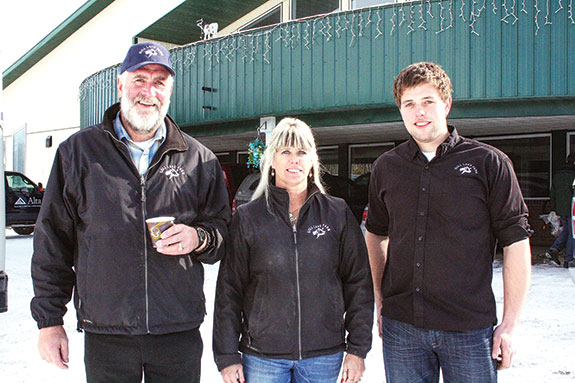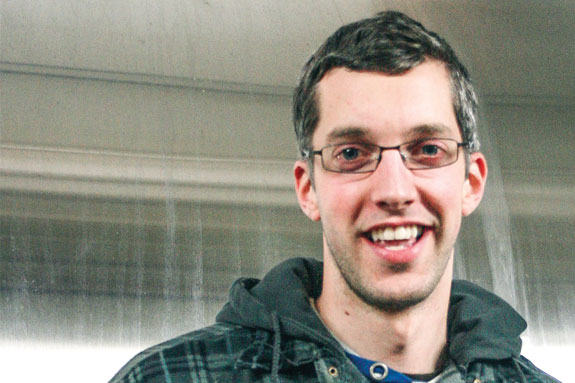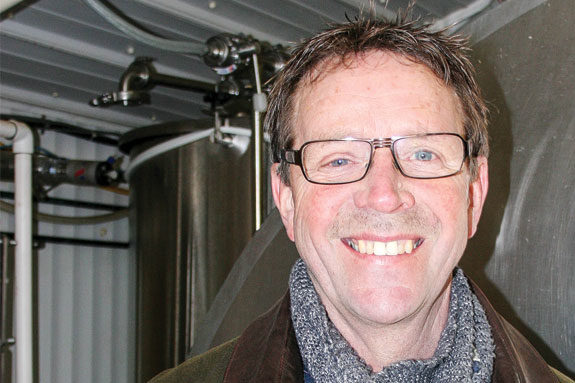As is tradition, three Alberta dairies graciously opened their farms to tours by attendees of the Western Canadian Dairy Seminars held March 5-8 in Red Deer, Alberta. Here is a glimpse into each of their operations.
Bles-Wold Dairy
When Hennie Bos and his wife, Tinie Eilers, moved their two children to Lacombe, Alberta, in 1994 to start a farm, they did not want to forget their roots. Bles-Wold Dairy is named for the two towns where they were raised in their native Holland.
The farm was built from scratch to suit their preferences. The main barn, with a double-10 parallel parlour, was completed in 1995.
A heifer and dry cow barn was built later, enabling the milking herd to grow and occupy the space previously held by the non-lactating animals.
A recent expansion to the milking barn included the installation of two automatic milking systems. Cows in their early lactation utilize the robots, allowing them to be milked as often as they wish. Late-lactation cows are milked twice a day in the parlour.
They are currently milking 270 cows but now have room to gradually grow to 350 cows. Average production is at 33 kilograms per cow with 3.8 percent butterfat and 3.4 percent protein.
In 2005, Bos began crossbreeding his Holstein herd with Fleckvieh semen to improve calving ease and reduce attention needed at transition. He now has 180 crossbred cows and all of the youngstock are crossbred.
“Their udder health is better with similar milk production compared to our straight-bred Holsteins,” Bos said.
The farm owns and leases 800 acres of cropland. They feed a total mixed ration of barley silage, oat silage, corn silage, haylage, dry hay, grains and a supplement.
Bos’ son-in-law, Ben Varekamp, is a partner in the farm. He works as the farm manager. Two other employees work on the farm, too.
About two years after they began dairying, they started processing yogurt on the farm. They market-tested their product at local farm markets in Red Deer and Edmonton. By the end of the season, a local co-op manager asked if he could sell the product in his store.
An old hip-roofed barn on the farm was remodeled to serve as the federally inspected processing plant. It is also an attractive location for on-farm sales and is open one day a week for customers.
An underground pipeline transports milk from the dairy to the processing facility. Approximately 5,000 litres of milk a week goes to yogurt production. All milk sent to the processing facility falls within the farm’s production quota.
The milk is pasteurized and mixed with yogurt cultures brought in from Denmark. Their product can be from the cow to the shelf in three days.
They produce yogurt, Greek yogurt, sour cream and drinkable yogurt. Nine different flavours are offered, but plain yogurt is their best seller.
Being a niche market requires a higher price, and they ask it. “It is a top-notch product,” Bos said. “We don’t compromise on quality.”
Marketed under the name Bos-Wold Yogurt Inc., they promote a fresh, locally produced product with no artificial additives.
Last year, Bos-Wold Yogurt surpassed $1 million in sales.
They do all their own distribution and sell to 130 stores throughout Alberta. They are looking to grow their market but struggle with local brand awareness in British Columbia and Manitoba. Distribution also becomes a problem the farther out it is sold, Bos said.
Along with adding value to the farm, this business also added labour. Six employees –four full-time and two part-time – work with the yogurt business. Gull Lake Farm Ltd.
Gull Lake Farm Ltd.
The Gull Lake Farm Ltd. was established in 2000 when Wim and Nita Floryn moved from Netherlands to Lacombe, Alberta.
They purchased a swine farm, demolished the buildings and built a new dairy facility.
The facility includes a 32-stall internal rotary parlour, freestall barns for 300 cows and room for 300 replacement heifers.
Currently they are milking a little more than 270 cows because they had to cull out some problematic staph-infected cows.
Their Holstein herd is 99 percent registered and bred using a presynch/ovsynch program.
Cows are milked three times a day and average 35 kilograms per cow daily.
In addition to Wim and Nita, their son, Marten, works on the farm. They also have four full-time and six part-time employees.
They farm 900 acres to supply feed to the farm. Their total mixed ration consists of corn silage, barley silage, alfalfa silage, corn grain, barley grain, a supplement, wheat and distillers.
To have more control over their ration, the Floryns recently added their own feed mill on the farm. Sunalta Farms
Sunalta Farms
Siebe and Froukje Brouwer sold their 40-cow farm in Holland and moved to Canada in 1991.
They started with 60 cows and now milk 300 at their farm near Ponoka, Alberta.
“We’ve been blessed,” said their son, JP Brouwer, who was just 4 years old when they moved and who now farms with his parents.
Their Holstein herd is 75 percent registered. They are milked three times a day in a double-16 parallel parlour.
The cows average 38 kilograms per cow with a 3.85 percent butterfat and 3.2 percent protein. “Components are down, but production is up,” Brouwer said.
The farm has a low somatic cell count of 106,000. This is in part due to their use of sand for bedding.
In November 2011, the Brouwers built a new freestall barn with a sand reclamation system. Freestall alleys are scraped to a gutter, which is flushed to the sand lane – a long concrete lane at a slight slope.
The sand settles on the lane while the manure-laden liquid continues down the lane to a pit.
Sand is scraped from the lane daily. In the winter, it is stockpiled outside, and during the summer it’s put in windrows to dry. Brouwer estimates they reclaim more than 90 percent of the sand.
The liquid in the pit is pumped through solid-liquid separators. The water is reused to flush the gutter or stored. Solids drop into a wagon and are stored behind the barn. In the future they would like to use the separated solids for heifer bedding.
They’ve been using a contract grower to raise their heifers but started raising their own calves this past January.
More than 400 acres are farmed. The total mixed ration consists of oat silage, barley silage, grass silage, ground corn, barley and a supplement.Six employees work on the farm. PD
PHOTOS:
TOP: Hennie Bos oversees both a 270-cow dairy and an on-farm yogurt processing facility.
MIDDLE: Wim and Nita Floryn and their son Marten operate a 270-cow farm they built from scratch on an old swine farm.
BOTTOM: JP Brouwer immigrated to Canada when he was 4 years old. He now runs a 300-cow dairy with his parents. Photos by Karen Lee.










